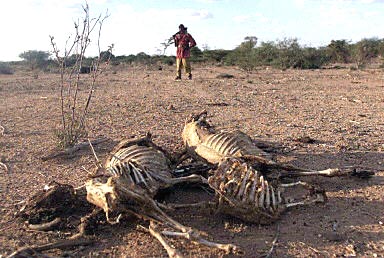Mannava Sivakumar, director of the Agricultural Meteorology Division at the World Meteorological Organization (WMO), who contributed to the chapter on droughts in the GAR 2011, wants countries to develop their own policies to tackle a climate event that remains poorly understood.
“A national drought policy will not only institutionalize the need for effective monitoring and setting up of early warning systems, it will empower a poor farmer affected by a drought to demand safety nets to protect him,” said Sivakumar.
Australia was so far the only country that had put in place a national drought policy to reduce risk “by developing better awareness and understanding” of droughts and the underlying causes of vulnerability of the communities exposed to them.
Risk identification and early warning are the priority areas identified by the Hyogo Framework of Action, a 10-year global policy approved by countries in 2005 to reduce disaster risks.
Whenever a natural hazard event such as a drought occurs, governments and donors have followed the set format of impact assessments, response, recovery and reconstruction, with little attention to risk management to “reduce future impacts, and lessen the need for government intervention in the future”, Sivakumar pointed out.
“The ultimate goal [of a national drought policy] is to create more drought-resilient societies,” he said. A drought policy would make it mandatory to provide safety nets such as insurance, and would sit well with developing countries' climate change adaptation plans. Droughts are expected to become more intense and frequent as the impact of climate change unfolds.
| 2010 Disasters which affected the most people | ||||||
| Events | Country | Numbers of people (in millions) |
||||
| Flood, May-August | China | 134 | ||||
| Flash flood, July-August | Pakistan | 20.4 | ||||
| Flood, October-December | Thailand, Cambodia | 9 | ||||
| Drought, March-August | Thailand | 6.5 | ||||
| Flood, June-August | China | 6 | ||||
| Earthquake, January | Haiti | 3.9 | ||||
| Flood, September | India | 3.3 | ||||
| Earthquake, February | Chile | 2.7 | ||||
| Drought, February-December | Somalia | 2.4 | ||||
| Flood, April-December | Colombia | 2.2 | ||||
| Source: Centre for Research on the Epidemiology of Disasters (CRED) Université catholique de Louvain - Brussels, Belgium | ||||||
This has been partly due to the limitations of the indices used to measure dry periods. In 2010, countries decided on the Standardized Precipitation Index (SPI), which could alert them to the onset of a drought two to three weeks after it started and prompt them to plan relief.
The SPI uses average rainfall over a period of at least 30 years as a variable to develop an early warning scale. A drought begins when the SPI is continuously negative for two to three weeks, and ends when the numbers turn positive.
Most nations have enough meteorological stations to measure rainfall. “There are very few countries that have problems with data, such as Somalia, which has been dealing with years of conflict,” said Sivakumar, but there are plans afoot to get Somalia, who is a member of the WMO, to set up automated weather stations.
To develop a national drought policy, the factors that heighten risk, increase vulnerability and broaden exposure need to be identified. As there are no credible global drought risk models, the GAR 2011 commissioned case studies around the world to identify some of the drivers that could turn a drought hazard into a disaster.
Climate variability and change, poverty, increasing demand for water as more and more people move to urban areas, bad management of soil and water; and weak or ineffective governance are among the factors that can escalate risk.
One of the most interesting examples of inappropriate management of soil and water presented in the report was Saudi Arabia’s policy in the 1970s to become self-sufficient in wheat production. By the early 1990s it had become the world’s sixth largest wheat producer, but this success came at a price - it drained the country’s aquifers, considerably expanding its exposure to risk. The policy was abandoned and Saudi Arabia now intends to depend completely on imported wheat by 2016.
WMO plans to hold a series of meetings of experts during 2011, ahead of a high-level summit on national drought policy in December 2012.
jk/he
This article was produced by IRIN News while it was part of the United Nations Office for the Coordination of Humanitarian Affairs. Please send queries on copyright or liability to the UN. For more information: https://shop.un.org/rights-permissions
